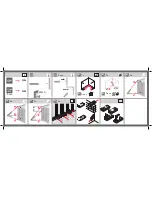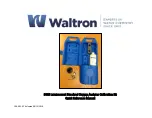
Nova Eclipse TG950 - Users Manual
36
Surface Geometry - Compound Contours:
For gaging on convex
surfaces such as piping elbows and spherical shapes, rock the probe for a
minimum reading in both the circumferential and longitudinal directions, and
use the smaller of the two minimum readings. Successful gaging on
concave surfaces depends upon the degree of curvature. If reliable
coupling cannot be achieved, the use of special probes may be required.
Various Mini-Probes are available that may suffice, but it is not feasible to
absolutely specify the minimum radii to which they will successfully apply.
Compound contours are difficult to gage. If successful results cannot be
obtained, it may be necessary to use an ultrasonic flaw detector such as the
Quantum TE or a thickness gage with A-Trace capability such as NDT
Systems' Eclipse TG-2.
Non-Parallel Surfaces:
The surfaces on both sides of a section must be
relatively parallel or concentric in order to obtain a satisfactory ultrasonic
echo for a thickness reading. Non-parallel or tapered surfaces will produce
less accuracy or no reading at all.
6.3 Material Temperature Effects
Both the dimensions and, especially, the ultrasonic velocity, of a material
change with temperature, which, in turn affects calibration and gaging
accuracy. This undesirable effect holds true for the material being gaged as
well as for the probe. Although it is always good practice to re-calibrate for
significant changes in ambient temperature, the effect can normally be
ignored for modest changes.
The situation becomes more complex when the material temperature is
considerably different from ambient. One solution is to calibrate on a
reference sample at the same temperature as the material. Another
solution is to calibrate on a reference sample at ambient temperature and
then add an experimentally derived correction factor for the temperature of
the material.
6.4 Additional Test M aterial Factors
Excessively Attenuative Materials:
Some materials (fibrous, porous,
large-grained, etc.) may absorb or scatter so much ultrasound that either a
reading cannot be obtained or some abnormal reading (usually abnormally
thin) occurs. In such cases, use the TG-208 Hi-Power Probe. If gaging is
Nova Eclipse TG950 - Users Manual
37
still unsuccessful, it may be necessary to use an instrument having an A-
Trace display, such as NDT Systems' Eclipse TG-2 or Quantum TE.
Grain Directionality Effects:
In both wrought and cast metals, the
microstructural properties frequently are directional. The ultrasonic velocity
(thus, gage calibration) may differ within the material, depending upon the
ultrasonic beam direction with respect to the grain direction. For optimum
measurement accuracy, calibrate, and subsequently gage, in the same
material grain direction.






































